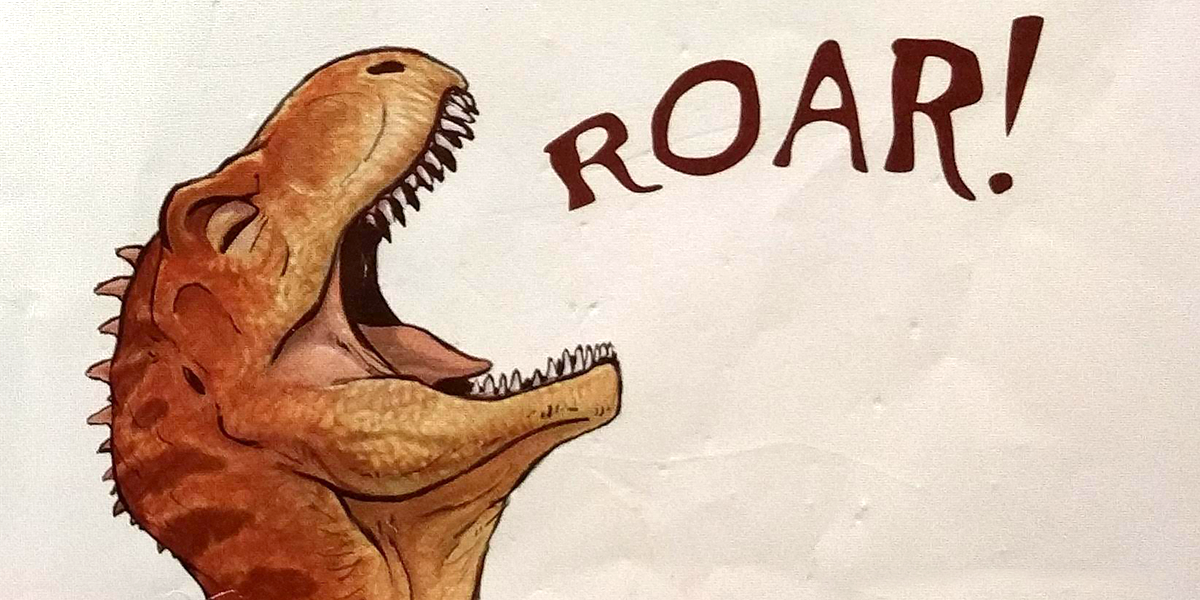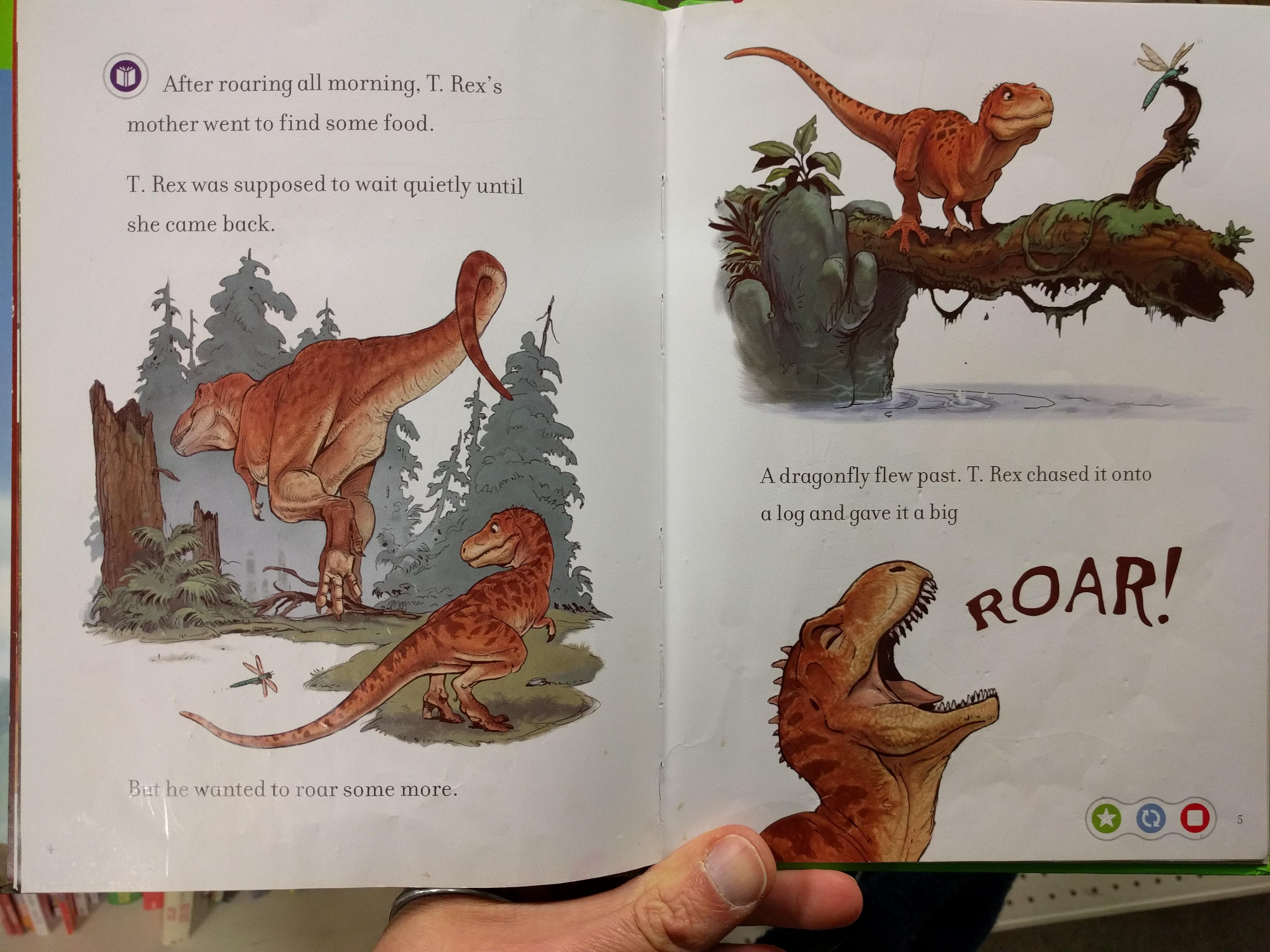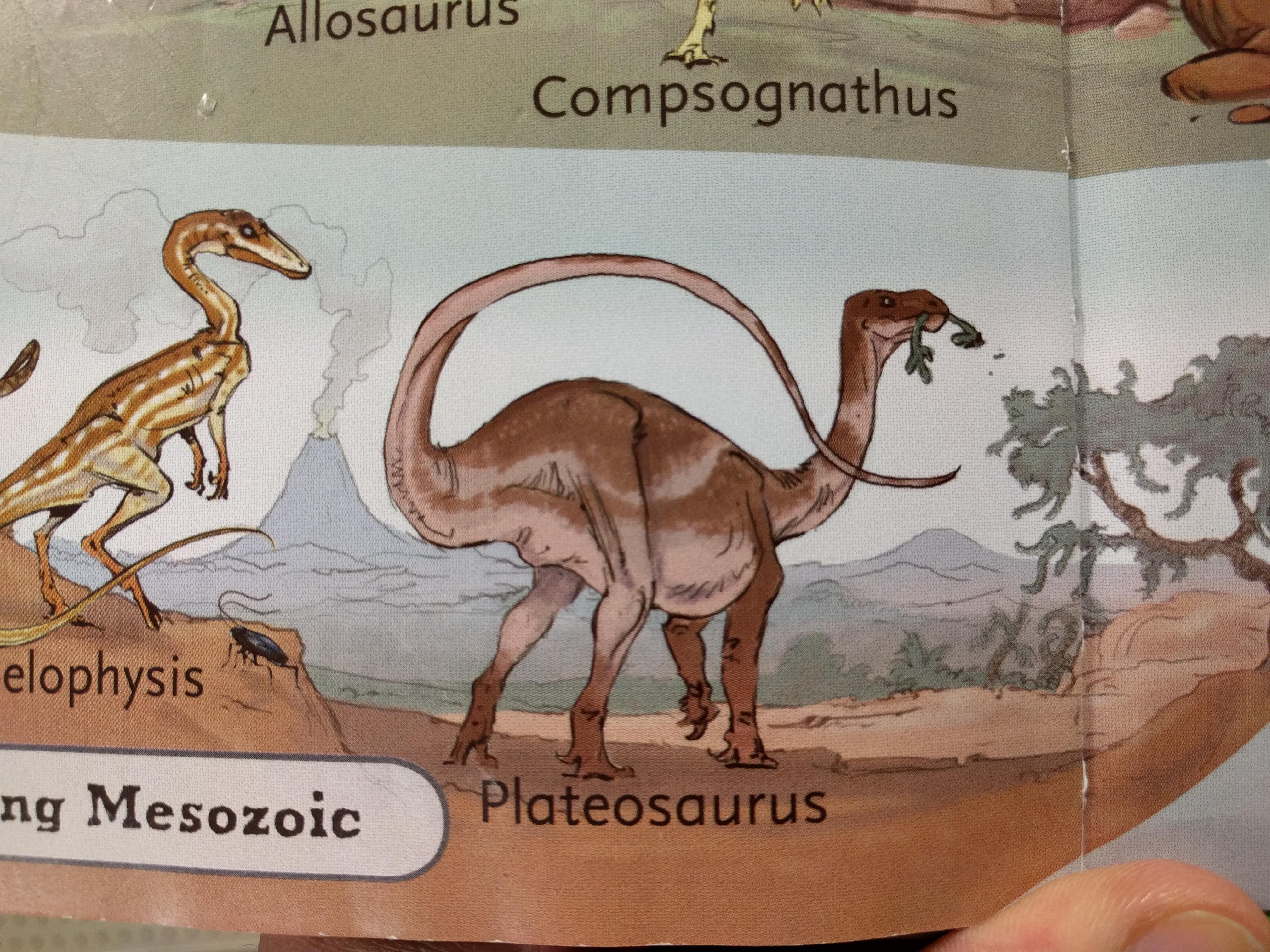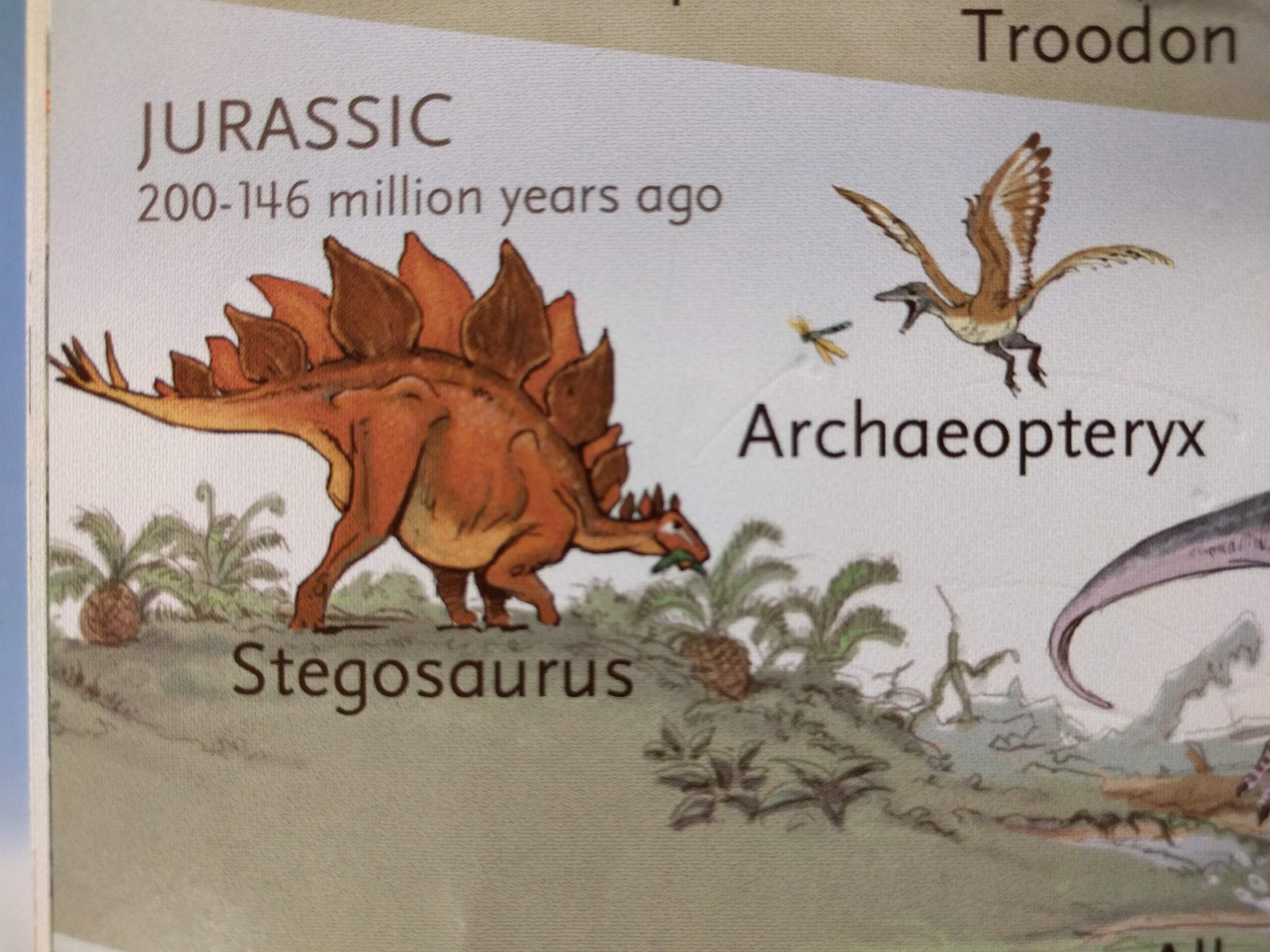One minute you’re browsing the questionable offerings of the Goodwill cookbook section, the next you’re stumbling upon a forgotten bit of a modern master’s paleoart oeuvre. As I scanned the children’s book shelves at one of the thrift store giant’s nearby locations, the title T. Rex’s Mighty Roar (sic) popped out at me. It was a dinosaur title. And that’s just what I was looking for. But it’s very rare that I find something as interesting as this. I mean, look at the cover. It’s a definitely a cut above the typical fare.
Paging through the book to get a feel for it, I was a little bit stunned. The attention to anatomical detail was there. The animals had interesting color schemes, the pages were playfully composed, and in general this illustrator took a lively and enthusiastic approach to the subject matter. The titular rexy was interacting with contemporaneous animals, even! Not a stegosaur in sight! It seemed way too good to be true.
When I flipped back to the title page, all was made clear. Check out that illustrator credit!
Yup, this is a Leapfrog interactive book illustrated by none other than David Krentz. Many of you surely recognize his name, as David is an engaged member of the paleoart community on Facebook, and long-time readers have seen plenty of his art shared in this space over the years. If not though, David has done amazing character design and animation work on Disney’s Dinosaur, Dinosaur Revolution and Walking With Dinosaurs 3D, and has been steadily employed as a storyboard artist for an obscure creative franchise called the Marvel Cinematic Universe.
I’m not sure when this title was released – as it’s technically a toy, it doesn’t have a publication date, but when I asked him, David remembered working on it in 2007, on a very tight timeline. So it probably came out in 2008 or so. Unfortunately, it was a one-and-done. The company shifted focus away from original titles to licensed properties.
The book tells the story of a young tyrannosaur encountering his fellow Hell Creek denizens and loudly making himself known along the way. It almost reads as a parody of the “always-roaring-theropod” trope, but more likely the authors, Ron Lytle and Scott Sonneborn, were just telling a comical tale that would be relatable to small children. It’s a bit of a missed opportunity that the little rexy wasn’t given a name – T. Rex (sic) is pretty unwieldy. I’ll call him Kevin.
As Kevin goes on his roaring spree, we are treated to a variety of poses, all full of life and personality. I can’t stress enough what a treat it is to see work of this caliber in a book that could very well have been handed to an illustrator with only a shallow grasp on the saurian physique. The art is definitely pushed into an stylized and cartoony direction, but not so much that we lose the details that make each species ring true. Kevin could stand to be a bit more elongated in the snout, but the zippy and gracile form of juvenile tyrannosaurs certainly comes through in the illustrations.
Though the glaring omission of Edmontosaurus wounds me, it a wide variety of animals get the spotlight. David told me that he remembered his favorite page from the book being the Ankylosaurus, and indeed, it is pretty damned awesome. It fills a whole page and stands out for the vague grasslike vegetation fully surrounding the grumpy ankylosaur, drawing the eye to that imposing visage.
There are some details to quibble over, like the undermuscled look of some of the animals, the unfeathered Troodon hands, and the proportions of Quetzalcoatlus (the head to body ratio could be pushed more in the head’s favor), but that’s just me ticking the critical checkboxes, and we are talking about work done 12 years ago, a veritable eternity in the Golden Age of Dinosaur Palaeontology. I love the charisma of this Troodon pack and the way they and Kevin regard each other.
The story ends with a visit to Alamosaurus, that mighty sauropod who technically had a more southerly range. It’s nice to imagine it wandering into Hell Creek. Kevin gives it a piece of his mind and momentarily thinks that he’s actually frightened it away, but no – it was mama, come to collect her wandering son.
After the story itself, there’s a nice illustrated timeline of the Mesozoic, bringing more iconic dinosaurs into the mix. Hopefully this person was not too scandalized by the accurate education about geological time.
Since we’re all here, let’s take a look at those little animals populating the chart, shall we?
A pretty awesome find, I think! As another bit of cool trivia, to David’s recollection he got the job because he had been recommended by Iain McCaig, who my fellow Star Wars fans probably remember for his amazing and sometimes terrifying prequel concept art.
David hasn’t stopped loving Tyrannosaurus, as you may remember his wildly popular Kickstarter from earlier this year. He doesn’t currently maintain a personal website, but be sure to follow him on Facebook and by yourself something nice from his Shapeways store and Redbubble shop.

























8 Comments
Niels Hazeborg
November 27, 2019 at 1:25 pmBeautiful!
Mustafa Ahmed
December 4, 2019 at 1:43 pmI don’t know about the Alamosaurus. Looks too diplodocid-like with its horse-esque head, equal length limbs, and undersized nostrils, and it fails at being a diplodocid too with those cursed elephantine feet and the like.
Niels Hazeborg
December 4, 2019 at 5:00 pmIt looks like a titanosaur head to me. ¯\_(ツ)_/¯ I also believe that longer frontlimbs are a uniquely Brachiosaurian feature, but I might be wrong about this. The feet could be better but they don’t bother me so much – at least there’s no nails on them. I agree about the nostrils.
Marc Vincent
December 5, 2019 at 2:43 pmNot exclusively brachiosaurian – see Scott Hartman’s reconstruction https://www.skeletaldrawing.com/sauropods-and-kin
Niels Hazeborg
December 5, 2019 at 5:24 pmHow much of Alamosaurus do we have? It seems the front limbs are quite a bit shorter than the hind limbs on the Hartman reconstruction, but the shoulder girdle is huge enough to give the animal a brachiosaur-like outline after all.
I assume Hartman’s skull is mostly speculative? I gather Alamosaurus is a saltasaurid or close to it, which makes the closest animal we have a skull for… something like Nemegtosaurus, maybe? I think the head Krentz has given it works pretty well for that.
(Let’s face it – the only reason anyone is interested in Alamosaurus at all is that it’s the only sauropod that could reasonably have met T. rex!)
Mustafa Ahmed
December 15, 2019 at 2:15 pmI was inspired by Saurian’s scrapped depiction of it.
https://sauriangame.fandom.com/wiki/Alamosaurus
David Krentz
December 6, 2019 at 2:44 pmWell, In my defense this was 12 years ago. A great deal has changed in that time. This was done pre-All Yesterdays, soft tissue revolution anti shrink wrap times.
Niels Hazeborg
December 6, 2019 at 6:35 pmYes, those were the days, weren’t they? I think it’s an inspired an forward-looking book, even if it would look different today.
As a matter of interest, what did you base the Alamosaurus on? Did the Perot museum mount already exist back then?